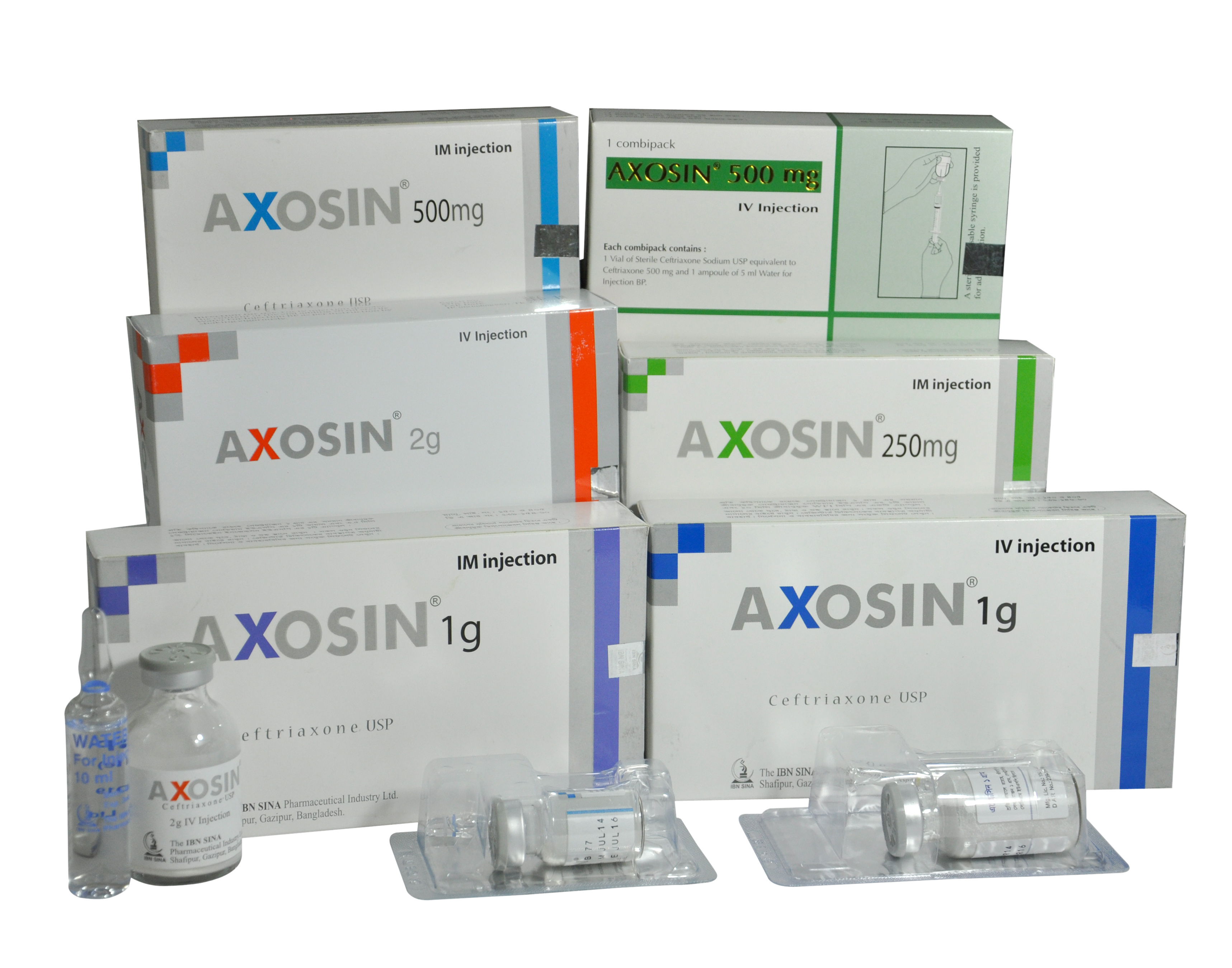
AXOSIN
CEFTRIAXONE SODIUM USP
| NAME | STRENGTH | PACK SIZE | DOSAGE FORM |
|---|---|---|---|
| AXOSIN 1 MG IV | 1 MG IV | 1 S | INJECTION |
| AXOSIN 250MG IM | 250MG IM | 1 S | INJECTION |
| AXOSIN 500 MG IM | 500 MG IM | 1 S | INJECTION |
| AXOSIN 1 MG IM | 1 MG IM | 1 S | INJECTION |
| AXOSIN 2 MG IV | 2 MG IV | 1 S | INJECTION |
| AXOSIN 500 MG IV | 500 MG IV | 1 S | INJECTION |
Axosin 250 mg IM and IV: Each vial contains Ceftriaxone 250 mg as Sterile Ceftriaxone Sodium USP. Axosin 500 mg IM and IV: Each vial contains Ceftriaxone 500 mg as Sterile Ceftriaxone Sodium USP. Axosin 1g IM and IV: Each vial contains Ceftriaxone 1g as sterile Ceftriaxone Sodium USP.
Axosin 2g IV: Each vial contains Ceftriaxone 2g as sterile Ceftriaxone Sodium USP
Axosin (Ceftriaxone) is a broad spectrum parenteral third generation cephalosporin antibiotic. The drug is highly resistant to bacterial beta lactamases and has a good activity against many gram-positive and gram-negative, aerobic and some anaerobic bacteria. It inhibits bacterial cell-wall synthesis in a manner similar to that of penicillin.
Axosin is indicated for the treatment of the following major infections when caused by susceptible organisms: - 1. Renal & urinary tract infections 2. Lower respiratory tract infections particularly pneumonia 3. Gonococcal infections 4. Skin, soft tissue, bone & joint infections 5. Bacterial meningitis 6. Serious bacterial infections e.g. septicemia 7. ENT infections 8. Infections in cancer patients 9. Prevention of postoperative infection 10. Pre-operative prophylaxis of infections associated with surgery 11. Typhoid fever.
Adult: It is usually given to adults in a dose of 1 to 2g daily as a single dose or in two divided doses depending on the type and severity of infection. In severe infections up to 4g daily may be given. A single intramuscular dose of 250 mg is recommended for the treatment of uncomplicated gonorrhea in adult. For surgical prophylaxis in adults, single dose of 1 g may be administered 0.5 to 2 hours prior to surgery; a 2 gm dose is suggested before colorectal surgery.
Children: Suggested doses for infants and children are 50 to 75 mg per kg body weight once a day; for severe infections up to 80 mg per kg body weight daily may be given.
Neonates: The maximum dose should not exceed 50 mg per kg; intravenous doses in neonates should be given over 60 minutes. Duration of therapy: The duration of therapy varies according to the course of the diseases. As with antibiotic therapy in general administration, Axosin should be continued for a minimum of 48-72 hours after the patient has become a febrile or evidence of bacterial eradication has been obtained.
Ceftriaxone sodium should not be given in patients with a history of hypersensitivity to cephalosporin antibiotics. It is contraindicated in premature infants and in full-term infants during the first 6 weeks of life.
In case of severe hypersensitivity reactions, treatment with Ceftriaxone must be discontinued immediately and adequate emergency measures must be initiated. Caution should be used if Ceftriaxone is given to patients with a history of hypersensitivity to other beta-lactam agents. An immune mediated hemolytic anemia has been observed in patients receiving cephalosporin class antibacterials including Ceftriaxone. Super infections with non-susceptible micro-organisms may occur as with other antibacterial agents. During prolonged treatment the complete blood count should be done at regular intervals.
Generally, well tolerated, side effects are relatively infrequent, usually mild and transient. The most common side effects are gastro-intestinal consisting mainly of loose stool, diarrhoea, nausea, vomiting stomatitis and glossitis. It may also cause convulsion & involuntary movement. So, perform tolerance test before use and administered the drug for 2-4 minutes.
Ceftriaxone crosses the placental barrier. Safety in human pregnancy has not been established. Reproductive studies in animals have shown no evidence of embryotoxicity, fetotoxicity, teratogenicity or adverse effects on male or female fertility, birth or perinatal and postnatal development. In primates, no embryotoxicity or teratogenicity has been observed. Low concentrations of Ceftriaxone are excreted in human milk. Caution should be exercised when Ceftriaxone is administered to a nursing woman.
Do not use diluents containing calcium, such as Ringer’s solution or Hartmann's solution, to reconstitute Ceftriaxone vials or to further dilute a reconstituted vial for i.v. administration because a precipitate can form. Concomitant use of Ceftriaxone with Vitamin K antagonists may increase the risk of bleeding. Coagulation parameters should be monitored frequently, and the dose of the anticoagulant adjusted accordingly, both during and after treatment with Ceftriaxone.
In case of over dosage, the symptoms of nausea, vomiting and diarrhoea can occur. Drug concentration would not be reduced by hemodialysis or peritoneal dialysis. There is no specific antidote. Treatment of over dosage should be symptomatic.
The recommended maximum storage temperature for Axosin vials is 25°C. Reconstituted solutions are stable for 6 hours at room temperature and for 24 hours at 5°C.
Axosin is supplied in a combipack as follows-
Axosin 250mg IM Injection: 1 vial of 250 mg Ceftriaxone Injection and one ampoule of 2 ml 1% Lidocaine USP injection.
Axosin 500mg IM Injection: 1 vial of 500 mg Ceftriaxone Injection and one ampoule of 2 ml 1% Lidocaine USP injection.
Axosin 1g IM Injection: 1 vial of 1 gm Ceftriaxone Injection and one ampoule of 3.5 ml 1% Lidocaine USP injection.
Axosin 250mg IV Injection: 1 vial 250 mg Ceftriaxone Injection and one ampoule of 5 ml water for Injection BP.
Axosin 500mg IV Injection: 1 vial 500 mg Ceftriaxone Injection and one ampoule of 5 ml water for Injection BP.
Axosin 1 g IV Injection: 1 vial of 1 g Ceftriaxone injection and one ampoule of 10 ml water for Injection BP.
Axosin 2g IV Injection: 1 vial of 2g Ceftriaxone Injection and two ampoules of 10 ml water for Injection BP.
